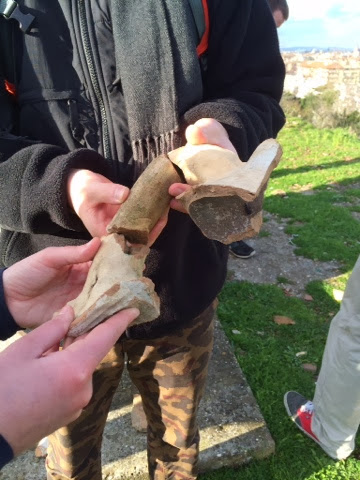Today we visited Monte Testaccio. At first glance, this appears to be nothing more than a grassy hill, except that there are broken fragments of clay pottery scattered upon it. Our guide revealed that this hill was once the equivalent of a land fill, where Romans deposited the fragments of old Amphorae, which were used to transport oil and wine. The fragments were carefully stacked until they formed this hill. Since then, soil has deposited and grass has grown on the hill, nearly disguising its intriguing past.
Our article discusses the ancient amphorae in some detail, and analyzes trade patterns based on evidence from the amphorae. Ship wrecks were particularly useful in finding fragments of amphorae for analyzation. They indicated that Italy was dominant in the trade of goods with amphorae, particularly wine, in the middle of the second century BC to the end of the 1st century BC. The amphorae were shipped to both France and Britain, along the Rhone valley and across the Rhine. After the 1st century, Italian dominance in the markets began to diminish, which was marked by Italy's increased importation. Northern Italy differed from other regions as it was open to Greek imports from the Adriatic.
Another interesting aspect of this article was its focus on the stamps found on the Amphorae. These stamps were often names or abbreviations, and some corresponded with Roman politicians at the time. Some believe this indicated a heavy involvement by these senators in the commerce of Amphorae. The article concludes, however, that these stamps more likely indicated the owners of the production equipment and land rather than the actual producers of the amphorae. The article notes that exploitation of the lower class amphorae producers, by the wealthier land owners was common place at the time and supported by the legal system.
We compared the seemingly misleading labeling practice of the amphorae in which the land owners, rather than the producers, were marked on the pots with labeling practices today. We noted that misleading labeling is still commonplace, but often takes a different form. In the article, the wealthier more recognizable names were used on the amphorae, potentially as a marketing technique, whereas today bigger companies often hide their relationship with certain products by labeling them under the names of smaller companies they own. One example that was brought up was Fanta. Apparently, Fanta was started by Coca Cola to be marketed in Germany during World War II without any backlash. Bigger companies also hide their involvement with smaller companies in order to capture niche markets that are resistant to more mainstream penetration.




No comments:
Post a Comment